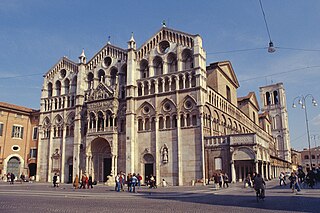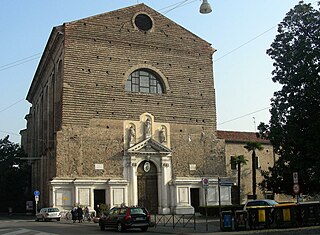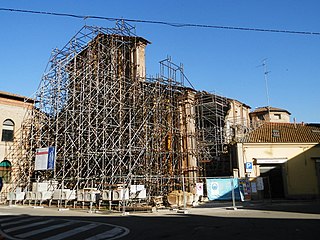


San Domenico is a Roman Catholic church and the adjacent former Dominican convent is located on the Piazza della Beata Colomba in the medieval center of the city of Rieti, region of Lazio, Italy.



San Domenico is a Roman Catholic church and the adjacent former Dominican convent is located on the Piazza della Beata Colomba in the medieval center of the city of Rieti, region of Lazio, Italy.
Construction was begun in 1242 and completed in 1268; refurbished in 1643-1644. [1] At one time it was endowed with numerous relics and richly decorated. The adjacent convent was linked to the early life of the Blessed Columba of Rieti, after whom the piazza in front of the church is named. The church had a single nave and the facade is built with travertine stone. The Romanesque belltower has a number of bells. It was abandoned in the 18th century, and in 1779, the diocese had proposals to raze the structure and rebuild a new church. The church was suppressed in 1810, but returned after the end of Napoleonic occupation. However again with the establishment of the Italian rule over the Papal states, in 1862 the Dominicans were again expelled, and the convent was used as army barracks. The church was deconsecrated by 1890, and used as a garage or armory.
By 1939, the Bishop of Rieti, Massimo Rinaldi, sought to reconsecrate the building. After the second world war, the commune over the next decades finally committed itself to the slow work of restoration. The earthquake of 1979 caused the roof to collapse, and repairs took decades. The church was reconsecrated in 1994, but restorations not completed until 1999. The sparse interior lacks the numerous side altars, many made with polychrome marble, once decorating the church.
The interior has a number of frescoes, most poorly conserved and some detached and moved to the civic museum. They include:
Behind the main altar is a monumental organ built from 2004 to 2009 by Barthélemy Formentelli, following 18th century essays by Dom Bédos de Celles (1760) and Roubo le Fils. [2]

Santa Maria Novella is a church in Florence, Italy, situated opposite, and lending its name to, the city's main railway station. Chronologically, it is the first great basilica in Florence, and is the city's principal Dominican church.

Santa Maria sopra Minerva is one of the major churches of the Order of Preachers in Rome, Italy. The church's name derives from the fact that the first Christian church structure on the site was built directly over the ruins or foundations of a temple dedicated to the Egyptian goddess Isis, which had been erroneously ascribed to the Greco-Roman goddess Minerva.

Cagli[ˈkaʎʎi] is a town and comune in the province of Pesaro e Urbino, Marche, central Italy. It c. 30 kilometres south of Urbino. The Burano flows near the town.

Pacentro is a comune of 1,279 inhabitants of the province of L'Aquila in Abruzzo, Italy. It is a well-preserved historic medieval village located in central Italy, several kilometers from the City of Sulmona about 170 kilometres (110 mi) east of Rome. It is a member of the I Borghi più belli d'Italia association.
Cesa is a comune (municipality) in the Province of Caserta in the Italian region Campania, located about 15 kilometres (9 mi) north of Naples and about 14 kilometres (9 mi) southwest of Caserta.

Sant'Anna dei Lombardi,, and also known as Santa Maria di Monte Oliveto, is an ancient church and convent located in piazza Monteoliveto in central Naples, Italy. Across Monteoliveto street from the Fountain in the square is the Renaissance palace of Orsini di Gravina.

San Marco is a religious complex in Florence, Italy. It comprises a church and a convent. The convent, which is now the Museo Nazionale di San Marco, has three claims to fame. During the 15th century it was home to two famous Dominicans, the painter Fra Angelico and the preacher Girolamo Savonarola. Furthermore, the church houses the tomb of Pico Della Mirandola, a Renaissance philosopher and the so called "Father of Humanism."

The Cathedral of St. Anastasia is the Roman Catholic cathedral of Zadar, Croatia, seat of the Archdiocese of Zadar, and the largest church in all of Dalmatia.

Ferrara Cathedral is a Roman Catholic cathedral and minor basilica in Ferrara, Northern Italy. Dedicated to Saint George, the patron saint of the city, it is the seat of the Archbishop of Ferrara and the largest religious building in the city.


San Francesco is a Gothic-style, Roman Catholic church in the lower town of Gubbio, Umbria, in Italy.

Santa Caterina da Siena is a Baroque architecture, Roman Catholic church in the district Venezia Nuova central Livorno, region of Tuscany, Italy. It stands in front of the Piazza dei Domenicani. The church is notable for its tall octagonal dome and lantern rising above a rough, unfinished rectangular base.

Ferrara Charterhouse, of which the present Church of San Cristoforo alla Certosa was previously the monastic church, is a former charterhouse or Carthusian monastery built in Renaissance style, located on Piazza Borso 50 in Ferrara, Region of Emilia-Romagna, Italy. The monastery was suppressed in the time of Napoleon, but the church was reconsecrated in 1813 and remains in use. The site also accommodates a large municipal cemetery, which was established in 1813.

The Basilica of Santa Maria della Quercia is a Renaissance-style, Roman Catholic sanctuary church and minor basilica, about two kilometer outside of the center of Viterbo, on the road to Bagnaia, in the Region of Lazio, Italy.

Sant'Agostino is a ruined Roman Catholic church in Amatrice, province of Rieti, Lazio, Italy. It was built in 1428 and it was dedicated to Saint Nicholas, but it was modified over subsequent centuries and rededicated to Saint Augustine of Hippo. Most of the church was destroyed in a series of earthquakes in 2016–17.

Fossombrone Cathedral is a Roman Catholic cathedral dedicated to Saint Aldebrandus and Saint Augustine located in the Piazza Mazzini at the end of Corso Garibaldi in the center of the town of Fossombrone in the province of Pesaro and Urbino in the region of Marche, Italy. Formerly the cathedral of the Diocese of Fossombrone, since 1986 it has been a co-cathedral of the Diocese of Fano-Fossombrone-Cagli-Pergola.

The Basilica del Carmine is a 16th-century Roman Catholic church located on piazza Francesco Petrarca in Padua, region of Veneto, Italy. It was made a minor basilica in 1960 by pope John XXIII

Santa Lucia is a Baroque-style, former-Roman Catholic church and the adjacent convent is located on Vicolo Santa Lucia #8 in the medieval center of the city of Rieti, region of Lazio, Italy. The church now mainly celebrates Roman Orthodox rites. The convent in 2020 houses the archaeologic collections of the Museo Civici of Rieti.

The church of San Francesco is a church located in Mirandola, in the province of Modena, Italy.

The church of San Francesco of Assisi is a Catholic religious building in Pavia, Lombardy, Italy.